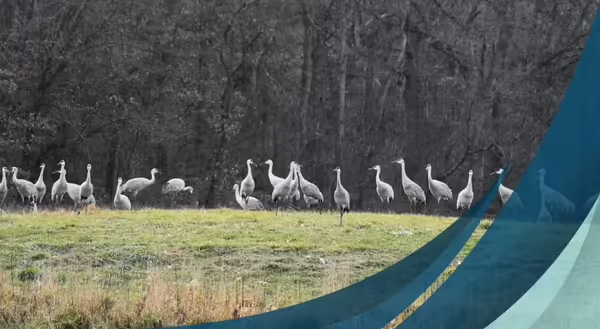
Walking outside on a nice fall day, you may be greeted by a strange, primal rattling sound coming from way high up in the sky. No, it’s not an alien invasion. It’s a flock of sandhill cranes making their way south for the winter!
Where can you see them?
Often these birds are heard before they are seen. Because of their elongated trachea which forms a loop in the sternum, their calls can be heard up to 2.5 miles away. Their large wingspan means they can soar on thermals, rarely flapping their wings. When traveling, they can stay aloft for many hours and often travel in flocks of hundreds of birds.
Sandhill cranes spend their summers throughout most of Canada and Alaska. Occasionally pairs will stay as far south as northern Illinois for the summer. In the fall they fly in large flocks down to locations in Texas, Mexico, and Florida, with a few western populations ending up in California. While some will spend the whole year in the south, most will then return in the spring to their breeding areas in the north. While migrating, it’s not a non-stop flight, however. They have layovers in a few areas that host large numbers of these very large birds. The nearest one is at Jasper-Pulaski Wildlife Refuge just across the state line in Medaryville, Ind. For hundreds of years, cranes have gathered in this marshy area to rest and refuel during their travels. Indiana DNR monitors population size during this time. As of Nov. 8, 2023, there were over 7,600 sandhill cranes. By the end of November, you can expect to see upwards of 30,000 birds hanging out in this one park! If you visit, there is a viewing platform where you can watch the cranes. The best viewing time is at dusk, when they all seem to congregate to have a bedtime snack and chat about their day.
It's all about the moves
Sandhill cranes are a large bird, standing almost 4 feet tall and weighing over 7 pounds. They are tan/grey with a striking red patch on their face. They are an ancient species with the oldest sandhill fossil found being 2.5 million years old. While they almost went extinct in the 1930s, thanks to conservation measures, population numbers have mostly recovered. They are LOUD. But their most intriguing behavior must be their dance skills. Sandhill cranes mate for life and their courtship routines include a beginning bow, spreading the wings and leaping while calling. And though this dance is most often about finding a mate, individuals will do it all year long and others will often join in.
Traveling companions
Occasionally, among the group of greyish brown cranes, you may be lucky enough to see a flash of bright white. Look closely—do you see black wing tips and a crimson cap? Then you’re seeing an endangered whooping crane! In the 1940s, the population of whooping cranes dropped to only around 20 birds. But through captive breeding programs, wetland management, and an amazing program that teaches the young how to migrate, there are approximately 600 today. Because of their small numbers, whooping cranes will sometimes tag along with a group of migrating sandhill cranes for the journey. There is safety in numbers, after all.
For more information on sandhill cranes and how you can see them, check out the University of Illinois Extension’s Naturalist News.